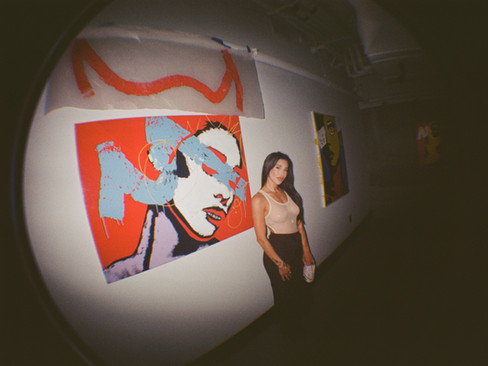BLISS: The Anatomy of a Moment
- OvonoAgency

- 1 day ago
- 6 min read
Solo Exhibition by Matthew Trujillo

Austin, TX – October 2, 2025
Written by Ovono Agency
Presented by ORO Art & ONO Agency
Photography by Evan H. Duvall
A Quiet Eruption in Color and Sound
There are nights when art doesn’t just hang on walls. It breathes, it moves, and it calls people into something larger than themselves. On October 2, 2025, Austin felt that pulse. The night of Bliss wasn’t a traditional art show. It was an atmospheric rupture, a collision of sight, sound, and emotion that turned an industrial space into a living, vibrating organism.
At the center of it all was Matthew Trujillo, whose canvases have long navigated the delicate chaos between street language and fine art poetics. His pieces, textured, defiant, yet heartbreakingly tender, seemed to speak in multiple dialects of color. Under the dim amber glow, viewers didn’t just see the work; they entered it. Each brushstroke seemed to echo Austin’s restless energy, part rebellion, part renewal.
The air itself felt electric, a low hum of conversation, music weaving through scent and light. There were no gallery ropes, no walls of separation. Bliss was immersive, a collective suspension of the ordinary. What emerged that night wasn’t just an exhibition but a shared state of consciousness.
The Collaboration
The creation of Bliss began months before anyone stepped foot into the venue. It was born from an ongoing dialogue between ORO Art, an Austin-based curatorial collective focused on multidisciplinary collaboration, and ONO Agency, an international creative network known for merging art, design, and culture across cities.
The partnership between ORO and ONO wasn’t a simple logistical pairing; it was a philosophical alignment. Both believe in dismantling the barriers between artist and institution, in seeing the creative process as something fluid rather than fixed. Early planning sessions blurred into voice memos, late-night sketch exchanges, and impromptu mood boards shared across time zones.
The exhibition’s architecture became a form of storytelling in itself, a conversation between Trujillo’s visual intensity and ORO’s spatial sensibility. ONO’s contribution extended beyond curation; it involved building narrative architecture, the language of the experience, the emotional pacing, and the textures of light and sound.
Together, these teams created something rare: a project that felt as spontaneous as it was deliberate. The partnership reflected a broader cultural truth, that the future of art lies not in competition but in collaboration. Bliss became proof that when creatives work across boundaries, between cities, mediums, and disciplines, the result transcends expectation.
The Artist’s Evolution
For Matthew Trujillo, Bliss was not just another exhibition. It was a threshold, a turning point that marked both artistic risk and personal renewal. Known for his striking sense of scale, layered symbolism, and raw use of material, Trujillo has long crafted a visual language that mirrors movement, both physical and spiritual. His art carries the rhythm of someone raised in flux, where displacement, resilience, and reinvention shape every brushstroke.
Yet Bliss revealed something more intimate, a surrender. Throughout its creation, Trujillo set aside the security of structure and leaned into instinct. He allowed chance, texture, and imperfection to guide him. What emerged were works that felt simultaneously fragile and fierce, compositions that breathed, trembled, and glowed with an energy that could not be contained. The palette spoke its own emotion: electric violets, rusted golds, and soft greys dissolving into cloudlike whites. They were not colors of control but of release.

This shift represented a profound evolution in his practice. Rather than orchestrating emotion, Trujillo allowed it to unfold. The gestures became looser, the edges more porous, the symbolism more fluid. Each piece carried the tension between mastery and vulnerability, the quiet bravery of letting go.
“You can’t depict happiness,” Trujillo once said. “You can only create space for it to exist.” That belief echoed through every inch of Bliss. The works were not declarations of joy but invitations to feel, to falter, and to expand. In embracing uncertainty, Trujillo reached a rare creative place where craftsmanship meets chaos, where the artist steps out of the way and the truth simply appears.
In this sense, Bliss was not just an exhibition of paintings. It was a portrait of transformation. It captured an artist in motion, unafraid to dissolve form, ego, and expectation in pursuit of something purer: a moment of genuine presence.
The Opening Night
The night of Bliss unfolded like a cinematic dream, each moment charged with texture, rhythm, and quiet revelation. The warehouse, nestled in East Austin’s creative corridor, pulsed with an energy that felt both intimate and electric. Its façade gave little away, but inside, the space transformed into a living organism of sound, color, and conversation. The air shimmered with anticipation as the walls, lined with Trujillo’s luminous works, seemed to breathe in sync with the music that rippled through the crowd. Outside, the evening sky melted into shades of violet and indigo, while inside, the glow of warm light spilled across canvases like moving language, alive, evolving, and impossible to contain.
Guests began arriving in waves, musicians still carrying the scent of rehearsal studios, designers dressed in bold contradictions, curators whispering notes to themselves, filmmakers documenting the moment, and street artists whose paint-stained hands told their own stories. The diversity of their worlds collided beautifully, forming a patchwork of Austin’s creative soul. The conversations floated between philosophy and laughter, between critique and confession, until the boundaries between art and audience dissolved completely.
The soundscape was as intentional as the paintings themselves, a hypnotic mix of deep ambient tones, distant city echoes, fragmented vocals, and slow-building percussion. It wasn’t background music; it was the heartbeat of the night. Every shift in rhythm mirrored the emotional terrain of the exhibition, moments of stillness followed by bursts of movement, much like the human experience that inspired Trujillo’s work.
Then came the silence, not forced or formal, but organic. A collective hush fell over the room as if everyone instinctively recognized something sacred unfolding. In that instant, art became communion. Eyes widened, breaths slowed, and a sense of unity filled the space. People weren’t just looking at the paintings; they were seeing themselves reflected within them.
Trujillo moved through the room almost unseen, humble, quiet, observant. His gestures were small but full of intent, greeting familiar faces, nodding to strangers, pausing in front of his own work as though he, too, was meeting it for the first time. He didn’t need to perform; his art did that for him. What defined the evening wasn’t spectacle but sincerity.
By the night’s end, Bliss had become more than an exhibition. It was an atmosphere, a pulse, a shared emotional frequency. The guests left carrying traces of it on their skin and in their hearts, like the afterglow of a beautiful dream. In a world often rushing past meaning, this night reminded everyone present of what art truly offers, not perfection, but presence. The real masterpiece was not hanging on the walls, it was the invisible thread connecting every soul in that luminous, fleeting moment of collective becoming.
Beyond Austin: A Global Thread
What made Bliss resonate far beyond its Texas roots was its context. The event marked the official Austin contribution to ONO Magazine’s Volume 1, a publication designed to connect creative cities, from New York to London, Stockholm to San Francisco, into one continuous dialogue.
Through ONO’s platform, Bliss became both a local celebration and a global conversation about artistic freedom, cross-city collaboration, and cultural renewal. In a time when many scenes turn inward, Bliss extended outward, reminding the world that artistic ecosystems thrive through connection, not isolation.
This ethos reflects a larger movement ONO Agency has championed, one where art doesn’t just occupy physical space, but emotional and digital space as well. By documenting and distributing stories like Bliss, ONO transforms fleeting moments into cultural memory.
In this way, Bliss wasn’t simply an exhibition. It was an anchor point in an expanding network of creative energy, a chapter in a larger, borderless story of global collaboration.
The Final Impression
Walking out into the Austin night, there was a sense that something ineffable had occurred. Conversations lingered long after the music ended. People hugged strangers, exchanged ideas, and made plans. The city felt momentarily different, softer, more alive, as if the vibration of Bliss had altered its frequency.
That’s the quiet power of art when it’s done right. It doesn’t just entertain. It shifts something internal. It gives permission to feel in ways that daily life rarely allows.
Bliss didn’t promise joy; it embodied the fleeting moment before joy, the hum before laughter, the hush before applause. It asked nothing but presence. And for those who were there, that presence felt like eternity.
As the lights dimmed and the last attendees drifted into the cool night, it became clear that Bliss wasn’t over. It had simply changed form, now living in the minds, the hearts, and the creative trajectories of everyone it touched.
And maybe that’s what real bliss is, not a state of perfection, but a moment of connection so pure it refuses to fade.















































